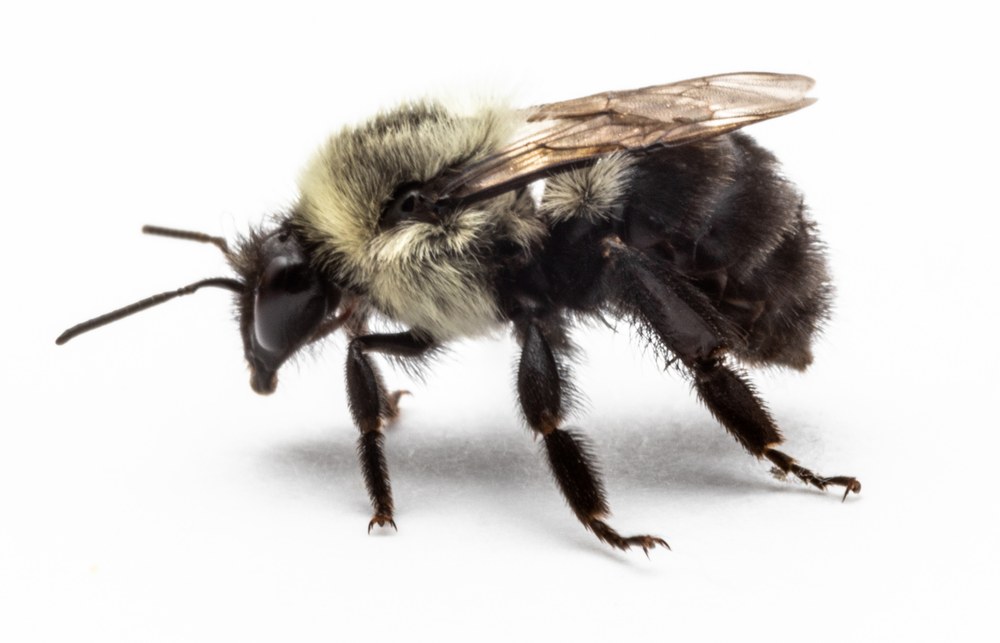Posted: July 15, 2020
In previous webinars, speakers have talked about how bees are very diverse and made up of over 20,000 distinct species. It is important to understand the different characteristics of these bee species, as they can greatly impact pollination management.

Bumble bees can greatly impact pollination management.
Honey bees and mason bees have both been covered by past presenters. In this webinar, Penn State Ph.D. candidate Erin Treanore explains the importance of bumble bees and how their unique biological characteristics and lifestyle is essential for pollination. While honey bees exhibit advanced eusocial behavior and mason bees exhibit solitary behavior, bumble bees present a unique combination of these behaviors known as primitively eusocial. In this primitively eusocial species, there is both a solitary and a social phase at different points of the year. Right after emergence in the spring, the queen lives similar to a solitary bee where she will spend the majority of her time finding a place to nest and collecting pollen and nectar for future offspring. The emergence of the new offspring marks the beginning of the social phase, where all the bees will live together in a colony.
Before the solitary phase begins, the queen spends about 6-9 months in winter diapause, a state that is similar to hibernation in mammals. Diapause can be a physiologically challenging life stage for the queens, as they must survive months in freezing temperatures while only relying on stored nutrient reserves. In the springtime, the queens will emerge and begin searching for a suitable site to found their colony. Since most bumble bees nest in cavities underground, they often nest in old rodent holes, rocky crevasses, under yard waste, and similar places. After the queen finds a suitable place to nest, she enters the colony foundation phase, in which she begins laying multiple eggs at a time in addition to foraging for pollen and nectar. About a month after the initial egg-laying, the social phase begins as the worker bees start to emerge and take over the colony tasks such as foraging, taking care of the developing brood, nest cleaning, and nest defense. The queen will then fulfill her role as the primary egg layer, as the worker bees take on these tasks. At the end of the social phase, the queen will start laying only males and potential queens called gynes. The males and gynes will then leave the colony to mate and the males will die off as the gynes enter winter diapause.
The biology of bumble bees makes them very efficient and effective pollinators. Their large body size, dense hair or pile, and ability to thermoregulate allow them to withstand living in cooler regions and at higher altitudes. These attributes also allow them to forage under colder and windier conditions than most bee species. Bumble bees are also able to "buzz-pollinate", meaning they rapidly vibrate their flight muscles to release pollen from the anthers. This form of pollination is essential for many agricultural and native plant species, such as tomatoes, eggplants, shooting stars, and more. In some cropping systems, bumble bees are able to deposit more pollen per flower than honey bees, meaning fewer visits are needed for successful pollination. In order for landscapes to receive the full benefits of bumble bee pollination, there should be a diversity of quality floral resources available at all stages of the colony life cycle, especially during the early and late stages.
Bumble bees can provide these pollination services to both agricultural and backyard settings. To best support the bees in agriculture, creating flowering reservoirs using cover crops or native plant species can provide bees with both nesting habitat and floral resources. Reducing pesticide exposure is especially important during the solitary phase of the life cycle since it may impact the queen's survival, egg-laying abilities, and colony development. Similar practices can be applied when supporting bumble bees in a backyard setting; including providing a diversity of high-quality floral resources, creating continuous blooming resources, and minimizing pesticide usage. Leaving compost, wood, leaves, rocks, and other natural areas undisturbed can provide potential nest sites for queens emerging in the spring. Unlike other species of bees, there is no specific bumble bee box that you can leave out that they are likely to inhabit. Occupancy rates of manufactured boxes are very low so it's best to focus on enhancing the natural habitat for bees rather than leaving out an artificial one.
To learn more about how to support bumble bee populations and habitats additional resources on bumble bee health and management will be linked below. Also to learn more about pollinators be sure to check out past webinars in this series and sign up for future ones!
Written by Ashley Moak
Full webinar descriptions and registration information
For additional questions you can contact Erin Treanore
Additional Resources:
- Bumble bee conservation and management
- Xerces Society
- Bumble bees of the Eastern United States
- Cover Cropping for Pollinators and Beneficial Insects
Research on Bumble Bees:

